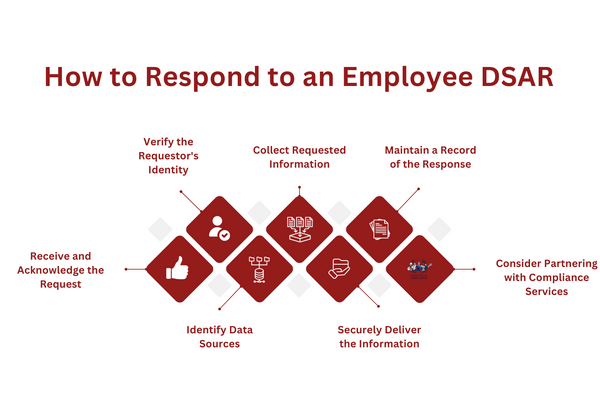
Consumers are often seen as the primary targets of data protection laws. However, employees also have certain privacy rights over their data.
One example is the right to access their data by submitting an employee Data Subject Access Request (DSAR). This includes anything from contact information and employment history to medical records and performance reviews.
Understanding your obligation regarding employee DSAR is vital to simplify data access for your workforce while ensuring compliance with data privacy laws. This guide will walk you through everything you need to know step-by-step.
Let’s dive in!
Key Takeaways
Responding promptly to employee DSARs is a vital part of compliance with data privacy laws. Failing to respond appropriately means risking fines, reputation damage, and other legal repercussions.
When responding to an employee DSAR, review the requested information for exemptions and only disclose the information you’re legally required to disclose.
If you don’t have the expertise to respond to employee DSARs in-house, consider partnering with a specialized service like Captain Compliance.
What is an Employee DSAR?
What is an Employee DSAR.jpg

First things first, a DSAR is a fundamental right under data privacy laws. It allows individuals to request access to their personal data held by an organization.
Many data privacy laws today, including the EU’s GDPR, Brazil’s LGPD, and California’s CPRA, empower consumers to access their data via DSARs.
However, employees also enjoy this privilege. In this context, “employee” refers to all workforce individuals, including job applicants, independent contractors, board members, etc.
When we talk about an “employee DSAR,” we’re referring to a specific request made by your own employees to access their personal information within your company.
In practice, this includes but isn’t limited to the following:
Medical records
Social media posts
Contact information
Disciplinary records
Employment history
Performance evaluations
Compensation information
Electronic communications (emails, messages, etc.)
The primary purpose of an employee DSAR is to empower your workforce. It gives them a glimpse into the personal data you hold about them. This transparency ensures that employees have control over their data and understand how it’s used.
Responding promptly to employee DSARs is vital for several reasons:
Trust and employee satisfaction
Compliance with data privacy laws
Data accuracy for efficient HR operations and decision-making
Risk mitigation and reinforcing your commitment to data protection
Responding appropriately to employee DSAR isn’t just about obeying the law – it’s about creating a respectful and trustworthy workplace for your employees, which ultimately benefits your business.
When Are Employee DSARs Common?
When Are Employee DSARs Common.png

Recognizing times that prompt employee DSARs helps you prepare to respond promptly and properly.
In doing so, you not only ensure compliance with data privacy laws but encourage a culture of trust and transparency within your organization.
Let’s briefly examine these scenarios:
Investigating Disciplinary Actions
When employees want to understand why disciplinary actions were taken against them, they may request a DSAR to access relevant documents.
This could include written warnings, performance improvement plans, or records of past incidents to understand the context and basis for disciplinary measures.
Checking for Errors in Personal Data
It’s not uncommon for employees to submit DSARs simply because they want to verify the accuracy of their data. They may want to ensure that contact details, employment history, or other personal information are up-to-date and error-free.
Concerns About Discrimination
If employees suspect workplace discrimination or harassment, they may request a DSAR to access relevant communication, reports, or records to address their concerns.
For example, employees who believe they have been discriminated against based on race or gender may submit a DSAR to access their performance reviews and disciplinary records.
Requesting Medical and Health Data
Employees with health-related concerns or those needing access to their medical records may use a DSAR to obtain these documents. This is especially relevant in industries where occupational health plays a significant role.
Resolving Pay Discrepancies
DSARs can be used to access information related to salary, bonuses, and other financial aspects. For this reason, employees may submit DSARs to review their payroll records and employment contracts to ensure they are being paid correctly.
Accessing Performance Feedback
Employees may submit DSARs to access records of their performance evaluations, feedback, and career development plans. With this information, they can track their progress and make informed decisions about their career within your organization.
How to Respond to an Employee DSAR
How to Respond to an Employee DSAR.png

To respond effectively to employee DSARs, you’ll need a structured process that outlines how you’ll acknowledge, verify, and respond to DSARs promptly.
Under data privacy laws, you typically have 30-45 days to respond to DSARs – 30 days under GDPR and 45 days under CPRA. That said, responding earlier (if you can) certainly couldn’t hurt.
Here’s a step-by-step guide to help you navigate this process:
Receive and Acknowledge the Request
The first step in your employee DSAR process should be acknowledging the request as soon as you receive it. You can do this via an email or a formal letter confirming that you’ve received and are reviewing the request.
Verify the Requestor’s Identity
Seems obvious, but you’ll need to confirm the identity of the person making the DSAR. This way, you avoid disclosing sensitive personal information to unauthorized parties.
To do this, you’ll need a verification process, particularly proof of identity, to ensure the request comes from the right individual.
Identify Data Sources
At this point, you’ll need to map out where all employee data is stored within your organization (if you haven’t already). We’re talking HR databases, email archives, personnel files, third parties, and any other data repositories.
On that note, leveraging effective data discovery software is a best practice for the most effective results.
Understanding your data locations is crucial to collect the requested information efficiently. Plus, it’s a vital starting point to comply with other data privacy obligations.
Collect Requested Information
After locating the requested information, you’ll need to collect and compile it in a clear, practical format to allow easy understanding for employees. When doing this, ensure you’re only collecting the bare minimum data necessary to fulfill the DSAR.
You should also make sure that you are not collecting any data that is exempt from the right of access under data privacy laws (more on this in the next section).
For example, you don’t need to disclose personal data that is subject to legal privilege, or that could be used to commit a crime.
Securely Deliver the Information
When providing the requested data, use secure and encrypted channels to protect the confidentiality and integrity of the information.
Make sure to inform the employee how to access their data securely. You can deliver the data electronically or in hard copy, depending on the employee’s preference.
If you are delivering the data electronically, you need to use a secure method, such as encrypted email, password-protected files, or secure online portals. If you are delivering the data in hard copy, you need to send it by registered mail or deliver it in person.
Maintain a Record of the Response
Document the entire process. In particular, keep records of when the request was received, how it was verified, and when and how the data was delivered.
Efficient record-keeping helps you demonstrate compliance and transparency in case of regulatory inquiries.
Consider Partnering with Compliance Services
For a smoother, more efficient DSAR process, consider outsourcing compliance to a dedicated compliance service provider.
You’ll want an experienced professional with top-notch DSAR software to help you manage DSARs effectively — in which case, there’s no better alternative to Captain Compliance.
Can You Legally Refuse a DSAR?
At this point, you might be wondering if there are situations where you can legally say ‘no’ to an employee DSAR. The answer is ‘yes,’ but it’s important to tread carefully. Here’s how:
Excessive or Unfounded Requests
Under data privacy laws, if a DSAR is “manifestly excessive or unfounded,” you have a legal right to refuse.
An excessive request, for example, might ask for too much information, while an unfounded request may lack a valid reason. For example, an employee may request hundreds of DSARs and request several copies through physical copies.
In such cases, you should inform the employee about the refusal and the reasons behind it.
Exemptions Under CPRA
The California Privacy Rights Act (CPRA) acknowledges that there are legitimate reasons for refusing a DSAR.
In short, the CPRA’s exemptions for DSARs include:
Security Risks: If providing the information could put your data security at risk, you have a valid reason to refuse.
Unreasonable Burden: If fulfilling the request places an unreasonable burden on your resources, you can legally refuse. This includes situations where collecting, verifying, or delivering the requested data is exceptionally complex, time-consuming, or costly.
Trade Secrets: Protecting your trade secrets and proprietary business information is another valid reason to decline a request.
Legal or Regulatory Obligations: Legal or regulatory obligations might prevent you from disclosing certain data, such as attorney-client privilege.
It’s important to remember that while you can refuse a DSAR in these situations, transparency and careful communication are crucial. Ensure you clearly explain why you’re refusing the request, maintaining a respectful and open dialogue with the employee.
How to refuse a DSAR under the CPRA
If you need to refuse a DSAR, you must provide the employee with a written explanation of your reasons for rejecting the request. You must also inform the employee of their right to file a complaint with the California Attorney General if they believe you have violated their rights under the CPRA.
That said, you should consider whether it is in your best interest to refuse a DSAR, even when you have a legal basis to do so. Refusing a DSAR can hurt your relationship with your employees.
If you are unsure whether or not you should refuse a DSAR, it’s always best to err on the side of caution and provide the employee with the information that they have requested.
What Happens if You Illegally Refuse a DSAR or Do Not Recieve All Necessary Details?
Illegally refusing a DSAR can lead to severe consequences for your business, including significant fines and reputational damage. Let’s take a closer look:
Fines and Penalties: If you unlawfully refuse a DSAR, you may be subject to substantial fines. Under the GDPR, fines can reach up to €20 million or 4% of your global annual turnover, whichever is higher. In the case of CPRA, non-compliance may result in fines of up to $7,500 per intentional violation.
Legal Actions by the Employee: If you illegally refuse an employee’s DSAR, the employee in question can take legal action against you. They may seek a court order to enforce compliance with the request or file a complaint with the relevant data protection authority, resulting in legal expenses.
Reputational Damage: Refusing or mishandling DSARs can harm your reputation and erode trust among your customers, employees, and partners. It may lead to negative publicity and impact your brand’s integrity.
Regulatory Scrutiny: Illegally refusing DSARs can trigger regulatory investigations and audits, leading to significant legal and financial burdens. Note that authorities may impose additional compliance measures or penalties beyond fines.
Closing
Employee DSARs are a chance to turn a potential compliance headache into a trust-building opportunity.
Now that you’ve gained a better understanding of employee DSARs, you’re ready to take the next step toward compliance. And we’re here to help you make this process easier and more efficient.
At Captain Compliance, we offer specialized data privacy compliance services tailored to your needs. Whether it’s establishing efficient DSAR response processes or navigating other aspects of data privacy laws, we’ve got you covered.
Ready to streamline your data privacy journey? Get in touch today!
FAQs
What exactly is an Employee DSAR?
An employee DSAR is a formal request made by one of your employees to access the personal data you hold about them. This request allows them to review, obtain copies of, or receive information about their personal data in your possession.
Check out what a Subject Access Request is all about
How long do I have to respond to an Employee DSAR?
Under data privacy laws like the GDPR and CPRA, you generally have a month (30 days) to respond to a DSAR. However, this isn’t set in stone.
Depending on case-specific circumstances, the 30-day timeframe can be extended 60 extra days. In any case, it’s crucial to establish a clear timeline within your organization.
Find out more about how long you have to respond to DSARs
Can I refuse an Employee DSAR?
Yes, but under limited circumstances. You can legally refuse a DSAR if fulfilling it poses security risks, places an unreasonable burden on your resources, involves irrelevant or excessive requests, or falls under specific exemptions as defined by data privacy laws.
Learn how to effectively manage DSARs for your business
What should I include in my response to an Employee DSAR?
Your response should include all the requested information along with a record of the verification process. It’s also essential to communicate the reasoning behind any refusals or redactions.